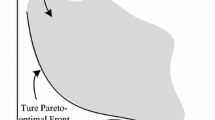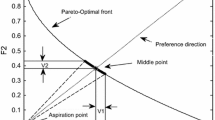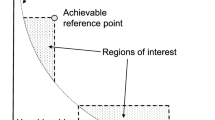Abstract
In traditional preference-based multi-objective optimization, the reference points in different regions often impact the performance of the algorithms so that the region of interest (ROI) cannot easily be obtained by the decision maker (DM). In dealing with many-objective optimization problems, the objective space is filled with non-dominated solutions in terms of the Pareto dominance relationship, since the dominance relationship cannot differentiate the mutual relationship between the solutions. To solve the above problems, this paper proposes a new selection mechanism with two main steps. First, we construct a preference radius to divide the whole population into two distinct parts: a dispreferred solution set and a preferred solution set. Second, the algorithm selects the optimal solutions in the preferred solution set by means of the Pareto dominance relationship. If the number of the obtained solutions does not satisfy the quantity’s upper limit, it selects those dispreferred solutions which have smaller distances to the reference direction until the number matches the size of the population. Experimental results show that the algorithm applying the mechanism is able to adapt to different reference points in varying regions in objective space. Moreover, it assists the DM in obtaining different sizes of ROI by adjusting the length of the radius of ROI. In dealing with many-objective problems, the mechanism can dramatically contribute to the convergence of an algorithm proposed in this paper, in comparison with other two state-of-the-art algorithms: g-dominance and r-dominance. Thus, this paper provides a new way to deal with user preference-based multi-objective optimization problems.
























Similar content being viewed by others
References
Adra SF, Fleming PJ (2009) Evolutionary multi-criterion optimization., A diversity management operator for evolutionary many-objective optimisationSpringer, Berlin
Adra SF, Griffin I, Fleming PJ (2007) Evolutionary multi-criterion optimization., A comparative study of progressive preference articulation techniques for multiobjective optimisationSpringer, Berlin
Aittokoski T, Tarkkanen S (2011) User preference extraction using dynamic query sliders in conjunction with UPS-EMO algorithm. arXiv:1110.5992 (arXiv preprint)
Bader J, Zitzler E (2011) HypE: an algorithm for fast hypervolume-based many-objective optimization. Evolut Comput 19(1):45–76
Ben Said L, Bechikh S, Ghédira K (2010) The r-dominance: a new dominance relation for interactive evolutionary multicriteria decision making. IEEE Trans Evolut Comput 14(5):801–818
Beume N, Fonseca CM, López-Ibáñez M et al (2009) On the complexity of computing the hypervolume indicator. IEEE Trans Evolut Comput 13(5):1075–1082
Branke J, Greco S, Slowinski R et al (2015) Learning value functions in interactive evolutionary multiobjective optimization. IEEE Trans Evolut Comput 19(1):88–102
Cheng R, Olhofer M, Jin Y (2015) Reference vector based a posteriori preference articulation for evolutionary multiobjective optimization. In: IEEE congress on evolutionary computation (CEC). IEEE, Sendai, Japan, pp 24–28
Chugh T, Sindhya K, Hakanen J et al (2015) An interactive simple indicator-based evolutionary algorithm (I-SIBEA) for multiobjective optimization problems. In: Evolutionary multi-criterion optimization. Springer, New York, pp 277–291
Cui XX, Lin C (2005) Preference-based multi-objective concordance genetic algorithm. Ruan Jian Xue Bao (J Softw) 16(5):761–770
Davarynejad M, Vrancken J, van den Berg J et al (2012) Variants of evolutionary algorithms for real-world applications., A fitness granulation approach for large-scale structural design optimizationSpringer, Berlin
Deb K (2001) Multi-objective optimization using evolutionary algorithms. Wiley, New York
Deb K (2002) Salient issues of multi-objective evolutionary algorithms. Multi Object Optim Using Evolut Algorithms 8:315–445
Deb K, Thiele L, Laumanns M, Zitzler E (2002) Scalable test problems for evolutionary multi-objective optimization. Congr Evolut Comput (CEC) 1:825–830
Deb K, Pratap A, Agarwal S et al (2002) A fast and elitist multiobjective genetic algorithm: NSGA-II. IEEE Trans Evolut Comput 6(2):182–197
Deb K, Zope P, Jain A (2003) Evolutionary multi-criterion optimization., Distributed computing of pareto-optimal solutions with evolutionary algorithmsSpringer, Berlin
Deb K, Sundar J, Udaya Bhaskara Rao N et al (2006) Reference point based multi-objective optimization using evolutionary algorithms. Int J Comput Intell Res 2(3):273–286
Deb K, Sinha A, Korhonen PJ et al (2010) An interactive evolutionary multiobjective optimization method based on progressively approximated value functions[J]. IEEE Trans Evolut Comput 14(5):723–739
Fonseca CM, Fleming PJ (1993) Genetic algorithms for multiobjective optimization: formulation discussion and generalization. In: ICGA, vol 93, pp 416–423
Fonseca CM, Fleming PJ (1995) Multiobjective genetic algorithms made easy: selection sharing and mating restriction
Greco S, Mousseau V, Słowiński R (2008) Ordinal regression revisited: multiple criteria ranking using a set of additive value functions. Eur J Oper Res 191(2):416–436
Hughes EJ (2005) Evolutionary many-objective optimisation: many once or one many? In: 2005 IEEE congress on evolutionary computation, vol 2005(1). IEEE, New York, pp 222–227
Jaszkiewicz A, Słowiński R (1999) The ‘light beam search’approach-an overview of methodology applications. Eur J Oper Res 113(2):300–314
Jin Y, Sendhoff B (2002) Fuzzy preference incorporation into evolutionary multi-objective optimization. In: Proceedings of the 4th Asia-Pacific conference on simulated evolution and learning, vol 1. Singapore, pp 26–30
Laumanns M (2001) SPEA2: improving the strength Pareto evolutionary algorithm
Molina J, Santana LV, Hernández-Díaz AG et al (2009) g-Dominance: reference point based dominance for multiobjective metaheuristics. Eur J Oper Res 197(2):685–692
Purshouse RC, Fleming PJ (2003) Evolutionary many-objective optimisation: an exploratory analysis. In: The congress on evolutionary computation, CEC’03, vol 2003(3). IEEE, New York, pp 2066–2073
Purshouse RC, Deb K, Mansor MM (2014) A review of hybrid evolutionary multiple criteria decision making methods. In: IEEE congress on evolutionary computation (CEC). IEEE, New York, pp 147–1154
Ruiz AB, Saborido R, Luque M (2012) A preference-based evolutionary algorithm for multiobjective optimization: the weighting achievement scalarizing function genetic algorithm. J Glob Optim 62(1):101–129
Santana-Quintero LV, Ramírez-Santiago N, Coello CAC et al (2006) Parallel problem solving from nature—PPSN IX., A new proposal for multiobjective optimization using particle swarm optimization and rough sets theorySpringer, Berlin
Sindhya K, Deb K, Miettinen K (2011) Improving convergence of evolutionary multi-objective optimization with local search: a concurrent-hybrid algorithm. Nat Comput 10(4):1407–1430
Thiele L, Miettinen K, Korhonen PJ et al (2009) A preference-based evolutionary algorithm for multi-objective optimization. Evolut Comput 17(3):411–436
Van Veldhuizen DA, Lamont GB (1998) Evolutionary computation and convergence to a pareto front. In: Late breaking papers at the genetic programming conference, vol 1998. Stanford University Bookstore, University of Wisconsin, Madison, pp 221–228
Wagner T, Beume N, Naujoks B (2007) Evolutionary multi-criterion optimization., Pareto-, aggregation-, and indicator-based methods in many-objective optimizationSpringer, Berlin
Wang R, Purshouse RC, Fleming PJ (2013) Preference-inspired coevolutionary algorithms for many-objective optimization. IEEE Trans Evolut Comput 17(4):474–494
Wang R, Purshouse RC, Giagkiozis I et al (2015) The iPICEA-g: a new hybrid evolutionary multi-criteria decision making approach using the brushing technique[J]. Eur J Oper Res 243(2):442–453
Wang R, Purshouse RC, Fleming PJ (2015b) Preference-inspired co-evolutionary algorithms using weight vectors. Eur J Oper Res 243(2):423–441
Yu G, Zheng J, Shen R et al (2015) Decomposing the user-preference in multiobjective optimization. Soft Comput. doi:10.1007/s00500-015-1736-z
Zhang Q, Li H (2007) MOEA/D: a multiobjective evolutionary algorithm based on decomposition. IEEE Trans Evolut Comput 11(6):712–731
Zitzler E, Künzli S (2004) Parallel problem solving from nature—PPSN VIII., Indicator-based selection in multiobjective searchSpringer, Berlin
Zitzler E, Thiele L (1998) An evolutionary algorithm for multiobjective optimization: the strength pareto approach. Computer Engineering and Networks Laboratory (TIK), Swiss Federal Institute of Technology Zürich (ETH)
Zitzler E, Deb K, Thiele L (2000) Comparison of multiobjective evolutionary algorithms: empirical results. Evolut Comput 8(2):173–195
Acknowledgments
The authors wish to thank the support of the Hunan Provincial Foundation for Postgraduate (Grant No. CX2013A011), the National Natural Science Foundation of China (Grant Nos. 61379062, 61372049, 61403326, 61502408), the Science Research Project of the Education Office of Hunan Province (Grant Nos. 12A135, 12C0378), the Hunan Province Natural Science Foundation (Grant Nos. 13JJ8006, 14JJ2072) and the Science and Technology Project of Hunan Province (Grant No. 2014GK3027).
Author information
Authors and Affiliations
Corresponding author
Ethics declarations
Conflict of interest
The authors declare that they have no conflict of interest.
Additional information
Communicated by V. Loia.
Rights and permissions
About this article
Cite this article
Hu, J., Yu, G., Zheng, J. et al. A preference-based multi-objective evolutionary algorithm using preference selection radius. Soft Comput 21, 5025–5051 (2017). https://doi.org/10.1007/s00500-016-2099-9
Published:
Issue Date:
DOI: https://doi.org/10.1007/s00500-016-2099-9




